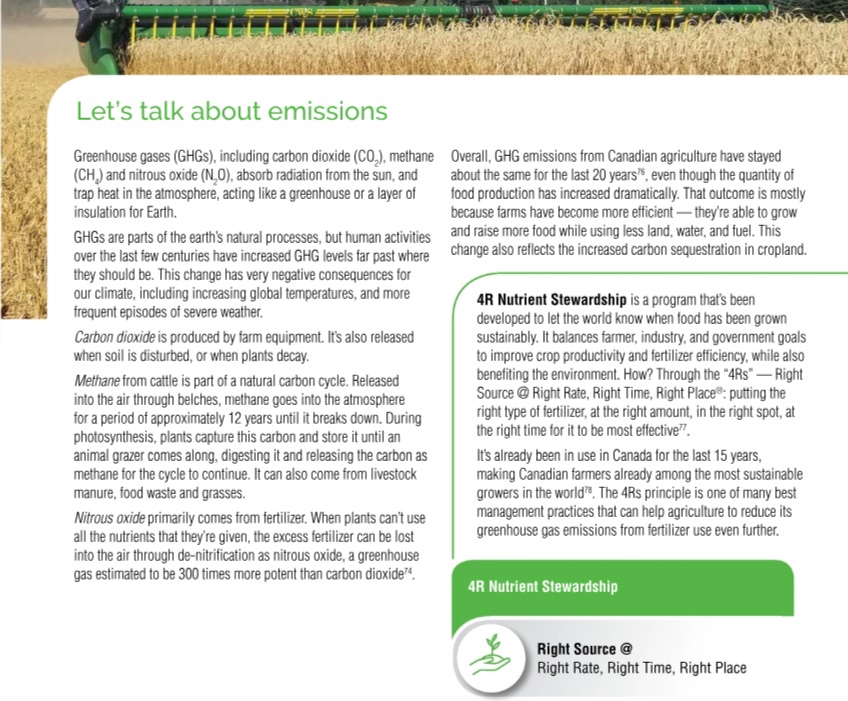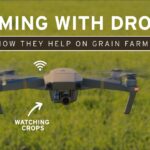Emissions, GHGs and agriculture

Education about climate change and the environment is found throughout the Ontario curriculum and provides a rich opportunity for cross-curricular learning.
Today’s farmers are at the forefront of action on climate change. They are the first to see the effects of intense weather events and are working to mitigate greenhouse gas (GHG) emissions and build resilient systems that support the environment and ensure a safe, consistent food supply.
The lowdown on emissions!
Emissions are complicated. We generally think about emissions coming from vehicles, but that’s not the whole story. We also think about carbon being harmful, but that is not the whole story, either.
What are emissions?
By definition, emissions are something emitted, such as electromagnetic waves and substances discharged by a chimney. Every living thing emits something—humans take in oxygen and emit carbon dioxide; plants take in carbon dioxide and emit oxygen.
Carbon and the greenhouse effect
Life on Earth is based on carbon. NASA’s Earth Observatory notes that humans “are made of carbon, we eat carbon, and our civilizations—our economies, our homes, our means of transport—are built on carbon.”
The Earth’s temperature is determined by the balance between energy entering and leaving the planet. Some gases in the atmosphere, known as “greenhouse gases,” absorb energy and slow down the loss of heat to space. These gases act like a blanket, keeping the Earth warmer than it would be otherwise, and are essential for making the planet habitable.
This natural process, called the “greenhouse effect,” is vital for life. Without it, the heat emitted by Earth would escape into space, and the planet’s average temperature would drop to about -20°C, making it too cold for life as we know it.
However, the problem arises from human activities that release large amounts of carbon dioxide (CO2) and other greenhouse gases. This excess CO2 has been accumulating in the atmosphere, trapping more heat and enhancing the natural greenhouse effect. This enhanced greenhouse effect, often referred to as “climate change,” is destabilizing ecosystems and altering the Earth’s climate in harmful ways.
Heat-trapping gases in the atmosphere create the greenhouse effect, which helps keep Earth warm enough to support life. These gases, primarily carbon dioxide, along with others like methane and nitrous oxide, are known as greenhouse gases. We call carbon and other gases in the atmosphere greenhouse gases (GHGs). The carbon cycle keeps Earth’s temperature stable over a period of a few hundred thousand years (think of a thermostat). But when the carbon cycle does not remain stable, its changes accelerate, occurring within 10,000 to 100,000 years. During those changes, Earth’s temperature can vary.
What are greenhouse gases (GHG’s)?
The most important gas influencing Earth’s long-term temperature is carbon dioxide (CO2). However, CO2 is not the only greenhouse gas (GHG), nor is it the most abundant.
But carbon is not the only GHG, nor is it the most abundant. In fact, water vapour is the most abundant GHG, by weight and by volume. It absorbs long-wave radiation and radiates it to Earth’s surface, contributing to warming. So why all the fuss about carbon? Longevity makes the difference; the longer a GHG remains in the atmosphere, the greater its effect.
The contribution of a greenhouse gas to the greenhouse effect depends on three factors: how much heat it absorbs, how much it re-radiates, and how much of the gas is present in the atmosphere.
In descending order, the gases that contribute most to the Earth’s greenhouse effect are:
- Water vapor (H2O)
- Carbon dioxide (CO2)
- Nitrous oxide (N2O)
- Methane (CH4)
- Ozone (O3)
In terms of how much heat these gases can absorb and re-radiate—referred to as their global warming potential (GWP)—methane (CH4) is 23 times more effective and nitrous oxide (N2O) is 296 times more effective than carbon dioxide (CO2). However, there is significantly more CO2 in the Earth’s atmosphere than CH4 or N2O.
Sources:
Agriculture and greenhouse gases
Agriculture is one of many human activities that produces GHGs. While human activity in general has increased the amount of GHGs in the atmosphere, Canadian agricultural emissions have remained stable over the past 20 years. During that time, farming has changed; new technology and practices result in farms producing more food for the world’s growing population without increasing the use of land, water, and fuel.
For an excellent overview of GHGs, see the Real Dirt on Farming, 6th Edition, page 25.

Farmers, dependant on weather, are at the forefront of the effects of climate change. And, while agriculture does have an environmental cost, it is one endeavour we cannot live without (we all eat food grown on farms!). Agriculturalists, therefore, are working to mitigate its effect by exploring new technology and new practices to protect soil and water, and use less fuel.
Grains are the most important food for feeding the world’s growing population—humans get nearly half their calories from grains, which also feed livestock—so the actions of grain farmers are particularly important. In fact, grain farmers’ sustainable farming and good stewardship protect the environment and support food security.
Practices they have adopted include:
- Planting cover crops to improve soil health
- Conservation tillage
- Modern technology
- Thoughtful use of spraying
- Adoption of 4R nutrient management strategies
Precision agriculture techniques
See more:
- Cover crops: great for soil and bees – Good in Every Grain
- Sustainable solutions: cover crops – Good in Every Grain
- Teaching the big topics – Good in Every Grain
- Farming to protect the soil – Good in Every Grain
Sources:
- Carbon cycle | Definition, Steps, Importance, Diagram, & Facts | Britannica
- The Carbon Cycle (nasa.gov)
- Main Greenhouse Gases – Center for Climate and Energy SolutionsCenter for Climate and Energy Solutions (c2es.org)
- Earth’s Changing Climate (nationalgeographic.org)
- What about water vapour? | Climate Change Connection
- The Principal Greenhouse Gases and Their Sources | The National Environmental Education Foundation (NEEF) (neefusa.org)
- Explained: Greenhouse gases | MIT News | Massachusetts Institute of Technology
- Earth’s spin, tilt and orbit – Understanding Global Change (berkeley.edu)
- What Is the Shape of Earth’s Orbit? | Sciencing
- Disturbing the Deep: New Research Reveals That Humans Have Intensely Impacted Earth’s Hidden Depths (scitechdaily.com)
- Grain (nationalgeographic.org)
For the classroom
Prompts for Class Discussion
Thought promoters for discussing emissions and agriculture with students
- Why do we need farms and farmers?
- Could we grow all our own food at our homes?
- Could we feed ourselves all year?
- What could we grow? What couldn’t we grow? (hint: grain!)
- Why do grain farmers need such big equipment?
- How else could they grow crops?
- How does using today’s farm equipment help farmers of the future? (hint: improving existing technology)
- What would happen if we stopped farmers from using their equipment to reduce emissions?
- If we did that, would we stop farmers from farming?
- Would people have enough food?
- Would there still be emissions?
Try this! Design an innovative farming machine (STEM Activity)
Students will learn about the engineering design process to solve a problem and help farmers farm with sustainable equipment. They will design their own innovative farming machine.
Learning objectives:
- Practise engineering design
- Learn farming processes to produce crops
- Learn about farming equipment
- Review environmental impact of agriculture
You can download the lesson plan, worksheets and slides here.



